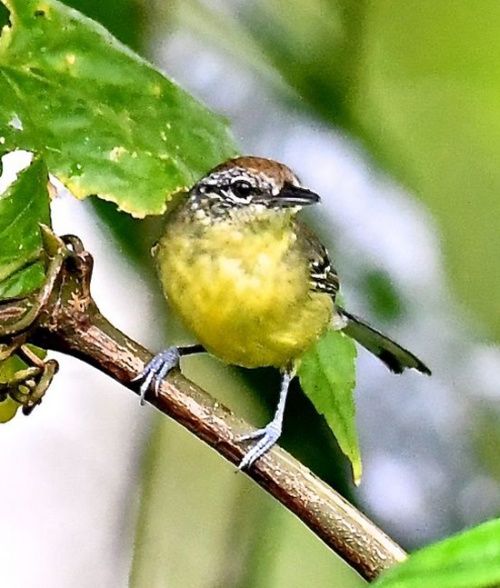(All sections now started. References. Incomplete gone) |
(Imp sizes. Basic tidy-up. Some extra info. References updated) |
||
| (One intermediate revision by one other user not shown) | |||
| Line 1: | Line 1: | ||
| + | [[Image:Yellow-breastedAntwrenGF.jpg|thumb|500px|right|Female<br />Photo © by {{user|Gerald+Friesen|Gerald Friesen}}<br />East Andes, [[Ecuador]], April, 2018]] | ||
;[[:Category:Herpsilochmus|Herpsilochmus]] axillaris | ;[[:Category:Herpsilochmus|Herpsilochmus]] axillaris | ||
==Identification== | ==Identification== | ||
| − | 11–12 cm<br /> | + | 11–12 cm (4¼-4¾ in)<br /> |
'''Male''' | '''Male''' | ||
*Black crown with white spots | *Black crown with white spots | ||
| Line 13: | Line 14: | ||
==Taxonomy== | ==Taxonomy== | ||
====Subspecies==== | ====Subspecies==== | ||
| + | There are 4 subspecies<sup>[[#References|[1]]]</sup> | ||
*''H. a. senex'': | *''H. a. senex'': | ||
:*Tropical and subtropical Western Andes of south-western [[Colombia]] | :*Tropical and subtropical Western Andes of south-western [[Colombia]] | ||
| Line 25: | Line 27: | ||
Humid montane evergreen forests and forest edges, at heights around 800–1900 m. | Humid montane evergreen forests and forest edges, at heights around 800–1900 m. | ||
==Behaviour== | ==Behaviour== | ||
| + | ====Diet==== | ||
| + | Their diet consists almost entirely of insects, and probably spiders too. They are rarely seen alone, but usually in pairs and family groups. | ||
====Diet==== | ====Diet==== | ||
They forage in pairs or family groups feeding on a variety of insects. | They forage in pairs or family groups feeding on a variety of insects. | ||
==References== | ==References== | ||
| − | #{{Ref- | + | #{{Ref-Clements6thAug18}}#Handbook of the Birds of the World Alive (retrieved January 2015 and March 2019) |
{{ref}} | {{ref}} | ||
==External Links== | ==External Links== | ||
| Line 34: | Line 38: | ||
| − | [[Category:Birds | + | [[Category:Birds]] [[Category:Herpsilochmus]] |
Latest revision as of 00:57, 9 March 2019
- Herpsilochmus axillaris
Identification
11–12 cm (4¼-4¾ in)
Male
- Black crown with white spots
- Whitish supercilium
- Mottled side of head
- Olive-yellow upperparts
Distribution
South America: found in Colombia, Ecuador, and Peru.
Taxonomy
Subspecies
There are 4 subspecies[1]
- H. a. senex:
- Tropical and subtropical Western Andes of south-western Colombia
- H. a. aequatorialis:
- Eastern slope of Andes of south-eastern Colombia and eastern Ecuador
- H. a. puncticeps:
- Eastern slope of Andes of northern Peru (Loreto to Huánuco)
- H. a. axillaris:
- Eastern slope of Andes of southern Peru (Junín, Cusco and Puno)
Habitat
Humid montane evergreen forests and forest edges, at heights around 800–1900 m.
Behaviour
Diet
Their diet consists almost entirely of insects, and probably spiders too. They are rarely seen alone, but usually in pairs and family groups.
Diet
They forage in pairs or family groups feeding on a variety of insects.
References
- Clements, J. F., T. S. Schulenberg, M. J. Iliff, D. Roberson, T. A. Fredericks, B. L. Sullivan, and C. L. Wood. 2018. The eBird/Clements checklist of birds of the world: v2018. Downloaded from http://www.birds.cornell.edu/clementschecklist/download/
- Handbook of the Birds of the World Alive (retrieved January 2015 and March 2019)
Recommended Citation
- BirdForum Opus contributors. (2024) Yellow-breasted Antwren. In: BirdForum, the forum for wild birds and birding. Retrieved 18 May 2024 from https://www.birdforum.net/opus/Yellow-breasted_Antwren




